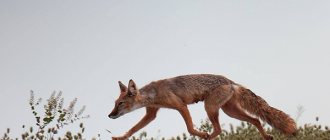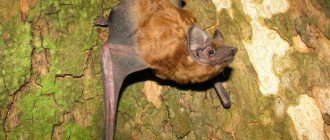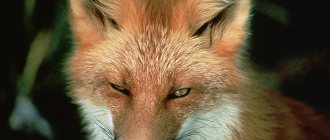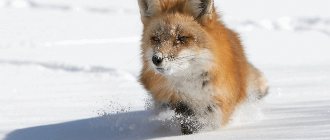It is impossible to distinguish a female from a male by its fur. At least, I didn’t find an answer to this question on the Internet. The colors and fluffiness are the same, depending on the habitat and season.
There are other ways. They are more complex and require attention. Foxes can be recognized by their barking. The girl makes a triple “bark” and stops emitting a short howl, the boy doesn’t howl like that, but he barks more often and longer, like a dog. This article has examples of recording their barking link.
You can also distinguish them by their marks. They relieve themselves, just like domestic dogs.
They also have different tracks. The female has a shorter stride and, judging by the drawing, the foot is more graceful. Although some hunters are able to distinguish the tracks of different foxes of the same sex.
Similar articles
Commander's belt tooth
The common fox or red fox is a predatory mammal from the canine family. This is the most common and largest species of its genus. The fox's body length is from 60 to 90 cm, its tail is 40-60 cm long, and its weight ranges from 6 to 10 kg.
Description of the red fox
The color and body size of the fox are very diverse and depend on the habitat.
There are 40-50 subspecies of this animal. In general, in the north of their range, foxes are usually lighter and larger, while in the south they are small and dull in color. In the mountains in the north you can also find black-brown and other dark foxes. The most famous and common color for this animal: a bright red back, a white belly, and dark paws. In the area of the back and shoulder blades there are often brown stripes resembling a cross. Common features also include dark ears and white-tipped tails. Externally, the fox is a medium-sized animal with an elegant body on thin paws, an elongated muzzle, pointed ears, a long and fluffy tail. Molting occurs in February-March and lasts until mid-summer. After this, the animal grows winter fur. The summer coat is short and sparse, the winter coat is thick and lush. A characteristic feature of a fox is its large ears, with which it picks up sound vibrations during the hunt.
Black Fox
Another variety, the black fox, has a similar pattern, but here it is not white, but blackish-gray, like the main color of the coat. The red variety has smooth, short, but gradually lengthening dark reddish-brown hair, covering the bridge of the nose with a white streak, while the black fox has an ash-gray coating. In the black variety, its darker color turns into ash-gray on the underside of the sides.
The red variety has a white tail, while the black variety has a dark gray tip. The forelegs of the first are yellow, the second are brown-red, the one with a whitish, and the other with a blackish-gray stripe on the inside. The basic coat color and pattern, which are exactly the same in male and female, are, however, subject to significant changes in both the red and black varieties, and in addition to the latter, there are reddish-black, tan, grey, pure white and motley specimens of foxes.
Occasionally you also come across so-called crosses - foxes that have a dirty yellow, brown, dark, sometimes even completely black stripe stretching from the nose along the head and back to the root of the tail, crossed by exactly the same stripe running along the shoulders. On the upper side of the fox's tail, approximately 6 centimeters from the root, there is a small gland covered with red bristly hair and secreting a liquid that spreads the smell of violets.
Feeding characteristics of the red fox
Foxes are typical predators, but their diet is very diverse. It includes more than 400 species of animals, as well as dozens of plants. Foxes rely on small rodents, mainly voles, for their diet. There are especially many of them in the winter diet of a predator: a fox is able to smell a rodent under the snow by its squeaking and rustling, and then with a quick jump dive under the snow, or scatter it with its paws in search of prey. This type of hunting is called mouse hunting.
Large mammals, such as hares, are caught less frequently by foxes. Sometimes large individuals attack roe deer cubs. Birds are caught only on the ground; clutches of eggs and flightless chicks are also destroyed. Poultry is rarely hunted. Foxes, inhabitants of deserts and semi-deserts, feed on reptiles. In Canada and northeast Eurasia, near large rivers, they eat salmon that died after spawning. In the summer, foxes eat beetles and other insects and their larvae. In times of hunger they can eat carrion. Plant foods (fruits, fruits, berries) are also included in the fox’s diet, especially in the southern subspecies.
Red fox distribution
The distribution range of the fox is very wide: it lives throughout Europe, in northern Africa (Egypt, Algeria, Morocco, Tunisia), in Asia (to northern India, southern China and Indochina), in North America from the Arctic to the northern Gulf of Mexico. The fox was acclimatized in Australia, and it took root on the continent, except for the subequatorial regions.
Foxes are unpretentious animals and inhabit all landscape and geographical zones: from the tundra and subarctic forest to the steppe and deserts, as well as mountains. Moreover, they are found not only in the wild, but also on the outskirts of cities, inhabiting landfills, parks and basements of houses.
Indian or Bengal fox
The animal is of moderate build. The body length is up to 60 cm. This is a short breed - up to 28 cm in height. The tail reaches up to 30 cm. The coat is mainly brown in color, from light to reddish. The end of the tail is always black. Representatives of the species settle in the foothills of the Southern Himalayas, Nepal, Bangladesh, and India. They do not like dense vegetation, but they also avoid deserts. For habitat they choose forests with sparse plantings, fields and mountains.
This fox almost does not feed on vegetation. But he loves to eat insects, arthropods, reptiles, birds, eggs and rodents. They are monogamous and bring up to 5 puppies at a time. They carry them for only a month and a half.
The animal is characterized by thick, silky and long hair. It is red or fawn in color above and white below. The animal is adorned with a rather pubescent tail with a black tip. In the wild, the animal lives in deep burrows with numerous tunnels. The animal does not walk alone; it prefers to be part of family groups of several individuals.
Red fox behavior
Throughout their wide distribution range, foxes prefer open areas, as well as areas with isolated groves, copses, hills and ravines. Among all climatic zones, the largest number of representatives of this species lives in the steppe and forest-steppe zone.
Foxes are usually sedentary and do not migrate. During resettlement, young individuals leave the den of their parents at a distance of 2-5 to 15-30 km. A pair or group of foxes occupies the so-called family plot, where the animals dig holes on their own or occupy the homes of a badger, marmot, or arctic fox. Foxes can even live in the same hole with badgers. Animals also use natural shelters such as caves, rock crevices, and tree hollows.
Red fox breeding
Foxes are monogamous animals and breed once a year. The timing of the mating season is related to the climatic conditions of each specific subspecies. Foxes are also excellent parents. Males take care of females during pregnancy and actively participate in raising the offspring. If the father of the family dies, then a single male takes his place, and fights even occur for the right to become a stepfather.
In winter, animals begin to search for places to breed their young, and carefully guard them. Unattended burrows are rare during this period; if a female dies, her den is immediately occupied by another. The female is looked after by 2-3 males, who fight among themselves all the time.
The duration of pregnancy is from 49 to 58 days. The litter ranges from 4-6 to 12-13 babies, with dark brown fur. Outwardly, they look like wolf cubs, but the tip of their tail is white. At the age of 2 weeks, fox cubs can already see and hear, and their teeth are cutting through. During this period, the female and male are very attentive and cautious, zealously protecting the offspring from danger, and they also hunt a lot to feed the babies. Milk feeding lasts 1.5 months, and the foxes are gradually accustomed to adult food and hunting. They leave the den at the age of about six months. With the onset of autumn, young males go 20-40 km from their parents, females - 10-15, in search of their own area and mate. Puberty occurs at the age of 2 years.
In the wild, foxes live from 3 to 7 years. In captivity, their life expectancy is 20-25 years.
Fox cubs
In the spring, from 3 to 12 small cubs are born in a fox hole. Like wolves, pups are born once a year. Newborns are very similar to wolf cubs, if you do not pay attention to the main difference, which is necessarily included in the description of a fox - the white tip of the tail. For a month and a half, the fox cubs sit in the hole, feeding on their mother’s milk, then they begin to slowly leave the shelter and even look for prey together with their parents, getting used to regular food.
Both parents participate in the educational process. The male is an exemplary family man, carefully caring for his female and offspring. The cubs are finally released from their holes at the age of 6 months, and already next spring some of them have their own cubs. But they usually reach sexual maturity in the second year of life. Foxes live in stable pairs. If it happens that the breadwinner dies, another male takes care of the family.
The fox is of great value as a fur-bearing animal. The description of the animal necessarily mentions luxurious fur, which can be not only red, but also silver and even black. But the main thing is that the fox is a destroyer of harmful rodents and insects, which brings invaluable benefits to agriculture.
Natural enemies of the red fox
The red fox population varies from year to year, but is generally high. The condition is affected by the number of rodents, climate, and infectious diseases. In hungry years, the fertility of females decreases, fewer puppies survive, and epizootics such as rabies, plague, and scabies spread. If there is enough food, then the number of foxes increases.
Interesting facts about the red fox:
- Foxes have a well-developed sense of smell and hearing. Their vision is adapted to the dark: they respond well to movement, but do not recognize color well, especially in the daytime.
- An excited animal emits a sharp, loud bark, and squeals during fights. It is by their voice that one can distinguish between a female and a male: the former is characterized by a triple “bark”, with a short howl at the end, while the male barks like a dog and never howls.
- The economic importance of the fox lies in the fact that it is a valuable fur-bearing animal, which also regulates the number of rodents and insects in nature.
- In order to obtain fur, foxes are specially bred in captivity. At the end of the 19th century, a breed of silver-black (silver-brown) fox was artificially bred. With the help of selection, the quality of her fur was improved, and on its basis, scientists developed a number of fur breeds: platinum, Bakurian, Dakota.
The common fox is one of the most popular fairy tale characters, closely associated with Slavic mythology. Many people associate this animal with deceit and cunning. It is familiar to every person since early childhood. But not everyone can boast of real knowledge about the natural habits and natural characteristics of such an animal as the common fox. And this is a rather interesting, unusual predator!
Victory over rabies. Conservation in nature
Despite the cunning mentioned in fairy tales, there are species of foxes that are endangered. The little-known fox from tropical South America is listed as critically endangered by the IUCN. The American corsac, a small (2 kg) North American prairie inhabitant, was found in the northern Great Plains of Canada from 1900 to 1970; Apparently, it was completely exterminated: in 1928 it disappeared from the province of Saskatchewan, and in 1938 from the province of Alberta. However, it has now been successfully reintroduced to the Canadian prairie. The Darwinian fox is also endangered in Chile.
The American corsac fox was one of many defeated wildlife as a result of the rapid westward movement of humans across the Great Plains of North America in the 19th century. In addition to habitat destruction due to agriculture and the spreading of poisoned baits against large predators, it was also hunted for its fur. Surviving populations in the northern United States were used to reintroduce the American Corsac fox into western Canada in the 1980s and 1990s. XX century.
Foxes are an example of amazingly fast evolutionary processes. Thus, 10,000-16,000 years ago, gray foxes reached the islands off the coast of California. The group of three northern islands at that time was the only one in the bay that the foxes reached either by swimming or by riding on any objects. The three southern islands were never connected to either the northern islands or the mainland, but foxes arrived there 3,000 years ago. These individuals were most likely brought from the northern islands by Indians who arrived in these places approximately 9,000–10,000 years ago. Island foxes, most of which are separated into independent subspecies, have become miniature copies of the mainland gray fox: they weigh only 1.1-2.7 kg, while their mainland counterpart weighs 5 kg. The reason for these differences is unclear as their habitats are very similar, but most likely they are related to diet. The island fox is mostly insectivorous, while the gray fox eats a wider range of vertebrates found only on the mainland. In the northern islands, the numbers of three fox subspecies have fallen sharply. Thus, on San Miguel Island the population consists of several individuals, while in 1993 it was several hundred. Of course, golden eagles' predation and disease played a certain negative role, but these factors cannot fully explain such degradation. To save these subspecies, a special plan was developed that included breeding foxes in captivity. But less than 200 kilometers south on San Clemente Island, another endemic subspecies of the island fox was extirpated by US conservationists in an attempt to eliminate predators of the endangered shrike.
Human attempts to manage and conserve fox populations face three challenges: hunting the animals for their fur, for sport, and killing them to reduce numbers, particularly in attempts to control rabies. In the 70s In the 20th century, fox skins came back into fashion, as they had before World War II, which caused a fishing boom. During the 1977-78 season. in North America, 388,643 common fox, 264,957 gray fox and 37,494 arctic fox were hunted. In 1978, approximately 1 million South American fox pelts were allegedly exported from Argentina. The fur market has emerged even in those countries that were not traditionally its producers. In Britain and Ireland, where there was no monitoring system, they began to harvest fur for the first time in recent history. It is estimated that 50,000–100,000 common fox pelts were exported from these countries in 1980. Soon after this, the fashion passed, and in 2000, British fox fur was again worth almost nothing.
All foxes suffer from rabies. Millions of animals were killed in a hopeless attempt to stop the spread of the disease. But the foxes turned out to be so tenacious that the population restored its numbers with a mortality rate of 75%. Population control underwent a revolutionary change in the 1980s and 1990s, thanks to the use of oral vaccination: baits (pieces of meat) filled with rabies vaccine were placed in areas where rabies occurs. The foxes that ate the bait were immunized and no longer developed rabies. As a result, the disease was eradicated from much of continental Europe—perhaps the greatest triumph for wild population management in the 20th century.
Origin of the species and description
Photo: Common fox
The common fox is a predatory mammal. It belongs to the canine family. The name comes from the Old Slavonic adjective “fox”. It meant a red, yellowish color. It is this that is most characteristic of this animal. The canine family is quite large. There are more than fifty subspecies of foxes alone. This figure does not include the smallest forms of this predator.
The common fox is the largest representative of its genus. The weight of such a predator can reach ten kilograms. The length of the animal including the tail usually does not exceed one hundred and fifty centimeters. The fox is famous for its bushy, long tail. It not only decorates it, but also performs a useful function - it serves as a kind of stabilizer while running. In the winter season, the tail protects foxes from the cold while sleeping.
Fun fact: Foxes share many traits with domestic cats. The peak activity of these animals occurs at night; they have excellent vision, similar hunting tactics, a rough tongue and protruding claws.
Common foxes are a valuable species of predator. They are of high economic importance. Such animals act as fur suppliers and are natural regulators of the number of rodents and small and medium-sized insects. However, it is foxes that bring great harm to humans. They can prey on poultry and are the main carrier of rabies, a dangerous and incurable disease.
Appearance and features
Photo: Common fox predatory animal
The fox is famous for its attractive, very interesting appearance, soft and beautiful fur. This is a fairly large predator, whose weight can reach ten kilograms and body length - ninety centimeters. The animal's tail has a length of forty to sixty centimeters. Its length will depend on the subspecies of the animal.
Common foxes have a strong jaw. In total, the animal has forty-two teeth, which can easily cope with almost any food. The predator's ears are characteristic: triangular in shape, slightly elongated, rather large. There is a sharp tip at the tip of the ears.
Video: Common fox
The animal's vision is excellent. They navigate the area well even in the dead of night. But, oddly enough, when moving and hunting, foxes are accustomed to relying not on vision, but on other senses: smell, touch. They have excellent hearing and a very sensitive nose.
The coat color of representatives of this genus may differ from each other. Foxes are red, yellowish, black-brown. Their fur is quite thick and dense. It is highly valued among people not only for its performance qualities, but also for its appearance. This fur looks impressive.
Interesting fact: All subspecies of the common fox, regardless of size and region of residence, have common features in appearance. All animals have dark ears and a white tail.
The summer fur of foxes is very short and sparse. Winter is more appreciated by people. It is thick and lush. Molting for these predators occurs from February to July. After this, the growth period of winter fur begins. By November, the chanterelles are fully dressed in winter wool.
Types of squirrels
The squirrel family includes 54 species, which have a unique appearance and live in certain places. Among them there are several main ones.
Common squirrel
Common squirrel
The species lives in Russia, Europe and Asia. It has an elongated body and a rounded head on which long ears are placed. The hind limbs are longer than the forelimbs. The color changes over the course of the year from light brown to brown.
Aberta
Aberta
Lives in the southwestern United States and Mexico. The animal has an elongated, rounded body. The belly and underside of the tail are white, and gray-brown fur grows on the back and face. Aberta's ears are long and have fluffy tufts at the tips.
Flying squirrel
Flying squirrel
Individuals of this species are small in size: their body length rarely exceeds 20 cm. Between the squirrel’s limbs there is a fold of skin covered with fur. It acts as a parachute and allows you to fly long distances due to oncoming air flows. In one jump, the flying squirrel is capable of covering 55-60 m. The species lives in the European part of Russia.
Ratuf
Ratuf
This species has another name – “Indian squirrel”. Individuals can boast of impressive dimensions: the body length reaches 50 cm, and at the tail this parameter can be equal to 65 cm. Ratufs live on the territory of the island of Hindustan.
Red-tailed squirrel
Red-tailed squirrel
It lives in South and Central America. The animal has a red belly and an orange-brown back. There is a black tassel at the tip of the tail. The squirrel's head is round in shape, with small ears without tassels at the top.
Western gray squirrel
Western gray squirrel
The animal lives in the forests of America. Its color is gray with a brown tint, its belly is white. In terms of lifestyle and appearance, it is almost no different from an ordinary squirrel.
Yellow-throated squirrel
Yellow-throated squirrel
The species gets its name from the yellow fur growing on its belly and neck. The back, muzzle and tail are red-brown. Individuals are small in size: body length rarely exceeds 17 cm. The animal lives in Venezuela and Brazil.
Where does the common fox live?
Photo: Animal common fox
The natural habitat of common foxes is quite wide. These animals live throughout Europe, Asia, North Africa, and North America. It was introduced and acclimatized in Australia. Now such an animal has spread throughout almost the entire continent. The exception is the territories located in the north. About fifteen subspecies of this predator live in Europe, and more than thirty in other countries.
In the above countries, foxes are found in all landscape and geographical zones. They feel great in the tundra, steppe, desert, mountains, and subtropical forests. At the same time, they easily adapt to different climatic conditions. The only exceptions may be areas with very high humidity. The population density of animals in geographical areas is completely different.
Interesting fact: Despite the high adaptability of foxes, a larger number of them were seen in the forest-steppe and steppe zones. They prefer open areas, despite the myth that such animals live exclusively in dense forest.
Most of the population of these predators lives in the wild. However, increasingly, foxes can be found near villages, towns, and cities. Single individuals have even been spotted by people in the central parts of large cities. Foxes have adapted perfectly to such conditions. They find food in parks, basements of residential buildings, city dumps, and agricultural buildings.
What does the common fox eat?
Photo: Red fox
Foxes are typical predators. However, their diet is wider. According to research by scientists, the diet of adults includes more than four hundred types of animal food and several dozen varieties of plant food.
However, the most common foods foxes eat are:
- Small rodents. They can be called the basis of nutrition for these animals. Foxes mainly hunt mice and voles. Scientists note that the state of the fox population in a particular region depends on the number and availability of small rodents;
- Zaitsev. They are less likely to become prey to predators. Only some subspecies hunt hares and hares with particular tenacity. And during a pestilence, a predator can even feast on the corpses of these small animals;
- Birds. These animals are not as important for the life of chanterelles as rodents. But the common fox will never miss an opportunity to catch and eat a bird for lunch. The beast attacks the birds when they are on the ground. Chicks that have fallen from nests and eggs become easy prey for predators. In conditions of hunger, foxes can attack poultry. They steal them straight from the barns;
- Insects. The common fox can snack on large beetles and their larvae. She will not disdain even dead insects;
- Plant food. It does not play a key role in the animal’s nutrition. Foxes rarely consume plant foods: fruits, fruits, berries, and various roots.
Fox hunt
The fox is a voracious, cruel predator, killing its prey even when it is full. During the summer, when the table is abundantly set for him, he becomes extremely picky about food and then loves to feast on the young calves of deer and wild goats. Pressing tightly to the ground, taking advantage of every cover, he crawls up to the helpless calf left for a while by his mother, so that in one jump he finds himself at his victim.
The fox knows how to take advantage of even young piglets, choosing for this the moment at which she has nothing to fear from an attack by a wild pig. She knows the holes and passages of the game very well and, moreover, selects points on them from which she can easily observe everything that is happening around her and make her successful jump at the right moment.
She first bites off the head of the caught victim, and then immediately begins to devour it. The fox leaves the rest of his lunch lying in place, sometimes covering it with dry leaves. She willingly eats small animals that emit a strong odor, such as shrews and hedgehogs.
It is not yet known how she copes with the latter; it is possible that she is as insensitive to the pricks of its needles as to the sting of wasps, bumblebees and bees, whose nests she intensively searches for honey and larvae. The fox takes out the birds caught in them from the snares and loops.
Features of character and lifestyle
Photo: Common fox
The most favorite time of day for common foxes is night. They hunt at dusk, and during the day they prefer to rest in their burrows. However, there are separate subspecies that can spend time searching for food during the day and sleeping at night. Foxes' burrows are very long and have several separate chambers. Animals break through them in the hills and slopes of ravines. The main purpose of burrows is shelter from danger and housing for future offspring.
Social structure and reproduction
Photo: Fox cub
The mating season of the common fox has the following features:
- Lasts only a few months: from January to March;
- Males can start small fights over females. However, the winner is not the strongest, but the smartest. Also during the mating season, these animals dance an unusual dance. They stand on their hind legs and walk one after another for a long time;
- At one time, a female can give birth to up to six cubs. Very rarely there are more than ten individuals in a litter. The children's ears are completely closed and there is no vision. They begin to see and hear only after the first two weeks;
- Fox cubs consume mother's milk for only a month and a half. Then they begin to get used to eating meat;
- Both parents feed the growing offspring. They have to get food almost all day long;
- A couple of months after birth, fox cubs can leave the hole on their own. Young individuals can be found quite far from their home and parents. It is then that they become victims of other, larger predators;
- The fox cubs become independent closer to autumn. At this time, they can leave their mother's house and build their own lives. Sexual maturity occurs at 1.5 years. In this case, males mature much later.
Natural enemies of common foxes
Photo: Common fox
Previously, the main enemy of foxes was people. Hunters indiscriminately shot these predators. This was done in order to exclude the possibility of the formation of a focus of rabies. Today, this problem is less acute thanks to the existence of an oral vaccine. The invention of the drug helped to significantly reduce the incidence of disease in mammals. It also eliminated the need for complete shooting of adults.
The shooting of common foxes has indeed decreased. However, these animals still suffer at the hands of humans. Many people hunt chanterelles for their own fun and excitement. Many adult animals die from traps set for other predators.
Among animals, foxes are often attacked by wolves and other predators that surpass them in size and strength. Lynxes, wolverines, and bears will never refuse to feast on a fox or its offspring. Stoats, ferrets and even badgers pose a certain mortal danger to foxes. Species living in the East die from the paws of tigers.
Young and small subspecies of the common fox suffer from attacks by large birds of prey. They are killed by eagles, falcons, hawks, sea eagles. But in general, foxes cannot be called easy prey. These animals are quite cunning, fast and excellent tree climbers.
Fox yelping
The yapping sounds usually made by a fox are somewhat reminiscent of the weak barking of a dog; she quickly repeats them five or six times in a row and ends her concert with a shrill and grunting howl.
These sounds foreshadow in winter, when they are heard mostly at night, the onset of very cold or bad weather. The fox also gives this voice during the mating period, but at this time it is accompanied by sounds reminiscent of the cry of a peacock.
More tender are the sounds with which the old woman attracts her half-grown fox cubs, already trained in the robber craft. With similar sounds, the cubs announce their hunger while they are still in the hole.
a fox, defending itself from dogs attacking it, grumbles angrily or growls dully. Very rarely, unless a bullet breaks one of her legs, she makes a plaintive sound that is difficult to describe.
The fox's endurance is remarkable: even when mortally wounded, it often runs away as quickly as if nothing had happened. Often she falls after the shot, convulsively shudders her legs and tail, gnashes her teeth again, and then remains motionless and pretends to be dead, but suddenly she begins to carefully move her eyes, takes a light sigh, jumps to her feet and - she was like that. It is no coincidence that in fairy tales the “dead” fox deceives the old man by throwing away the fish from the sleigh that the old man had previously caught.
Population and species status
Photo: Animal common fox
To date, there is no accurate data on the number of common foxes. However, it is known that the population of these predators is quite high. But, unfortunately, it tends to fluctuate.
Fluctuations in fox numbers are influenced by the following factors:
- Meteorological and climatic conditions in the natural habitat;
- Number and availability of small rodents;
- Prevalence of infectious diseases.
During severe frosts or drought, the level of fertility of females drops, and a smaller percentage of offspring survive to maturity. Under such conditions, the risk of various diseases increases. Several dozen, or even hundreds of foxes can die from one rabies or plague in a region almost simultaneously.
Despite the existing difficulties, the population of common foxes is sufficient throughout the entire natural range. This predator is not included in the Red Book, it is not classified as a conservation mammal, and the status of the species is stable and causes the least concern. In the wild, foxes can live for about seven years. However, the percentage of such animals is very small. Often these predators die before they even reach the age of three. In captivity, the animal lives several times longer. On average, about twenty years.
The common fox is a very interesting, beautiful animal. It is of great economic importance. It has very valuable fur, and the animal itself can be safely called a natural regulator of the rodent population. Foxes are distributed almost throughout the planet and easily adapt to different climatic conditions.
How to smoke a fox out of a hole
Before you start smoking a fox out of a hole, you need to make sure that it is in it. If a fox hides in a hole, then the hunter is waiting not only for its structure, which is often quite ingenious (especially if we are talking about a nesting or century-old hole), but also for the very system of protective holes that we talked about above. And even taking into account the uncleanliness of foxes, it can be extremely difficult to find the red beast in the heap of shelters scattered throughout its feeding area. In this regard, the experience of Canadian zoologists is interesting, who, when studying the foxes of the province of Ontario, at one time used an ingenious method of searching for them in its shelters. It was as follows: in May-June, in those areas where foxes were supposed to exist, they laid out the carcasses of freshly killed woodchucks, having previously placed radio sensors in neutral plastic boxes in their chest cavities. The foxes took the treats to their holes, thereby revealing their location to the person. We understand that hunters in the post-Soviet world can hardly afford such a luxury as a radio sensor for a fox, so we report this only as an entertaining fact - although perhaps this information will be useful to someone.
The paradox is that while there are quite a large number of ways to smoke a fox out of a hole, each of them has both supporters and opponents. Some methods have not stood the test of time, others are not entirely legal, others are good only for certain cases and purposes... The only thing that all experienced hunters agree on is the opinion that if a fox goes into a hole, it is almost impossible to drive it out of there, or at least very difficult.
The most common solution to the problem is to smoke out the fox with the help of a dog. The essence of the method is this: quietly and quietly sneak up to the hole, put the dog in there and just wait for the result. If the fox cannot figure out the hunter and if the hole is not a dead end, then, escaping from the dog, it will jump out quite quickly. If you have been identified, the fight will drag on for a long time. However, a number of hunters have recently abandoned this practice, citing a number of compelling arguments. Indeed, to hunt foxes, you need specially trained dogs of certain breeds (the so-called “burrow dogs”), and you need to spend several years training them, and it is unknown how the dog will behave if it finds itself in the same hole with a fox. It is not uncommon for a dog to die after being buried in a hole. Many believe, and not unreasonably, that by throwing a dog into a fox hole, they lose control over the situation, and the dog becomes the master of the situation, and not the hunter, and this is fraught with damage to the skin and a number of other troubles - even to the point that the dog can strangle the fox in a hole and bury it there. Some hunters complain that when hunting with the help of a dog, a lot of time passes in empty anticipation while the dog drives the fox out of the hole. There is also a lot of debate about which dogs are best suited for this type of work: hounds and dachshunds are traditionally considered the best, but there are also good reviews about huskies. Summarizing all the impressions based on the individual experience of each hunter, we can draw the following conclusion: it is impossible to give any general recommendations on this matter, so you just need to take it and try it, after talking with experienced trappers about all the nuances.
If there is no dog, and it is necessary to smoke the fox out of its hole, then the main question is why it is necessary to drive the animal out of its shelter. If the hunter’s goal is to obtain a skin and then sell it, then you need to carefully choose the smoking method - not all of them are humane to the animal. If we are talking about exterminating foxes in order to limit their population in a particular area, then, as they say, “all means good in war.” We do not undertake to analyze and evaluate each of the methods developed over the years, but simply list the main ones, which, although often subject to criticism, are quite effective.
So, you can smoke a fox out of a hole in the following ways:
- using smoke in the hole.
- pyrotechnics.
- metal cable.
- using an “artificial ferret.”
- regular capture of offspring for two to three years.
- water.
- using an old diesel tractor (a method invented in the Soviet Union).
- traps.
Smoke is perhaps the first thing that comes to mind, despite the fact that this method is subject to severe criticism from some hunters. It consists of the following: it is necessary to seal all the exits in the hole, except one, and build a fire near it so that the smoke penetrates into the hole. Many hunters advise not to plug all the exits, but to leave one or two so that natural draft spreads the smoke throughout the hole. Opinions also differ about what to make a fire on: some say that dry wormwood is best suited for smoking, others advise using rubber. Sometimes it is recommended to use a smoke bomb based on saltpeter instead of a fire. The technology of the method is simple: since the fox is most often in the lower part of its labyrinth, therefore any impact on it, not excluding smoke, will lead to the fact that it will run to the exit, where the hunter will be waiting for it. However, opponents of this method argue that in some cases - for example, when a fox is in a state of rut - the effect of smoke is completely opposite: it will hide even deeper into the hole and would rather suffocate than get out into the fresh air. In addition, it should be taken into account that the fox is more patient than a person and, in case of danger, will definitely wait it out: there were cases when hunters, having not achieved quick success, left the hole, and the fox crawled out alive and well on the third or even fifth day.
Some fox hunting enthusiasts advise using ordinary firecrackers. The calculation is based on the noise effect, which intensifies in a confined space, as a result of which the fox also leaves the shelter that has become unreliable. However, this method is criticized because of its danger - first of all, for the hunter himself: it is no secret that the quality of the pyrotechnics sold often leaves much to be desired, and when buying it for fox hunting, you unwittingly acquire the notorious “pig in a poke.”
A metal cable is a more original solution to the problem, although it is also not indisputable. The essence of the method is as follows: one end of the cable is pre-fluffed, the hunter plugs all the exits, leaving only two, and begins, by twisting, to drive this cable with the fluffed end into the hole. Having reached the fox, the cable will definitely catch its skin, and the animal will involuntarily leave the shelter. This method takes into account the direction of the hole, so many hunters recommend it as the most accurate and effective.
A variation of the method is the use of an “artificial ferret” (or wrapping). However, to use this method you need three people. The cable is a steel wire with a diameter of 3-4 mm, at one end of which there is a handle, and at the other - a rubber toy. One hunter puts a toy on a wire into a hole, the second turns the handle, and the third stands with a gun at the ready. Sometimes, instead of wire, a regular plumbing snake with a steel brush at the end is used. The main thing in all variations is the sufficient length of the cable. But this method is applicable only if the fox hid in a simple hole. For nesting or century-old burrows, this method is useless.
Catching offspring is used if there is a “fight to the bitter end” with foxes. It is carried out like this: at the beginning of May, in previously explored nesting holes, all nesting holes are plugged with pipes with grates at both ends. At one end there is a blind grille, at the other - fixed at an acute angle along the way, on an axis that allows entry only in one direction. If there are not enough pipes, the least accessible holes are clogged tightly with stumps and stones and covered with earth. Chicken giblets are laid out in pipes. All fox offspring are caught in this way. The method should be applied regularly for several years, then the fox will go away on its own.
Another method from the same arsenal is to fill the hole with water. It is used if you can drive up to the hole. The method is extremely simple: nets are installed on the holes, a tractor with a barrel of water is driven to the hole, and water is released through the holes into the hole. The only nuance that you need to pay attention to is the following: if you want the fox alive, then you need to fill the hole from non-working holes and let in a little water at first. After this method, the hole becomes abandoned for a long time.
Using an old diesel tractor is perhaps one of the most barbaric methods of fighting foxes, which can only be justified by the huge number of foxes and the inaction of regional sanitary services. This method is as follows: the tractor is driven to the hole, a hose about five meters long is put on the exhaust pipe and pushed into the hole. The remaining space is sealed with sweatshirts to prevent smoke from escaping into the sky. If there is only one entrance to the hole, then the hose should not be sealed very tightly so that the fox can knock out the plug. As soon as smoke comes out of any hole, it must be shut up immediately. The last snout need not be closed, but if the fox does not come out for a long time, then they close it too. Periodically, the tractor driver must change the throttle. The essence of the method is to ensure that all diesel smoke remains in the hole. From its abundance, the fox becomes sick and eventually comes out in such a state that it is very easy to kill.
Finally, the last method is to place traps near the hole and visit after three to four days. If the trap is well camouflaged, then the fox will definitely fall into it. However, this method is subject to severe criticism from those who prefer to hunt with dogs.
There are several other ways to smoke a fox out of a hole, but they are either too exotic (such as using thread from an old woolen sock), or belong to the arsenal of poachers, so we will not talk about them.











